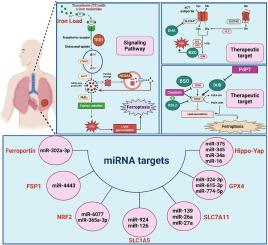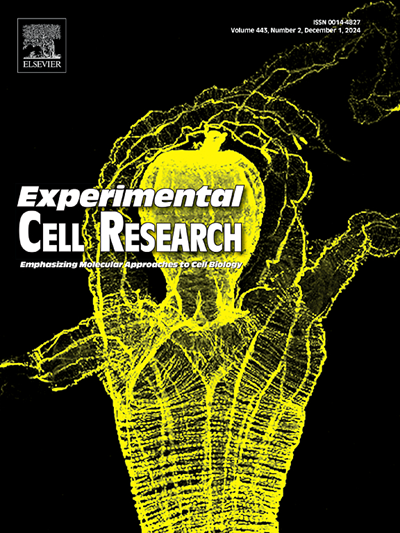新见解:miRNA 对肺癌中铁蛋白沉积途径的调控。
IF 3.3
3区 生物学
Q3 CELL BIOLOGY
引用次数: 0
摘要
新发现的程序性铁依赖性坏死(ferroptosis)是一种新型途径,受铁依赖性脂质过氧化和细胞氧化还原变化的控制。它可以通过低抗氧化酶活性内在触发,也可以通过阻断氨基酸转运体或激活铁转运体外触发。铁变态反应的诱导涉及特定蛋白质的激活、转运体的抑制和内质网(ER)应激的增加(ER 是参与蛋白质折叠和加工的重要细胞器,在这种情况下,错误折叠或未折叠蛋白质的积累会使ER不堪重负。这种情况扰乱了细胞内质网的正常功能,导致一种被称为 "未折叠蛋白反应 "的细胞应激反应),导致脂质过氧化副产物积累和有毒的活性氧(ROS),活性氧是来自二原子氧的高活性分子,包括超氧化物(O₂-)、羟自由基(-OH)和过氧化氢(H₂O₂)等各种形式。铁突变与肺癌中的信号分子密切相关,包括表皮生长因子受体(EGFR)、丝裂原活化蛋白激酶(MAPK)、缺氧诱导因子 1-α(HIF-1α)和 P53,并受微小 RNA(miRNA)等表观遗传因子的调控。 miRNA 是小型非编码 RNA 分子,通过与目标信使 RNA(mRNA)结合,导致翻译抑制或降解,从而调控基因表达。研究发现,有几种 miRNA 可通过靶向参与铁代谢、脂质过氧化和抗氧化防御途径的关键基因来调节铁变态反应。有关铁突变的研究已扩展到其在肺癌治疗和抗药性预防中的作用。本综述概括了铁蛋白沉积在肺癌中的重要作用。了解肺癌细胞中铁蛋白沉积的机制和影响可能会导致靶向疗法,利用癌细胞对铁蛋白沉积的脆弱性,改善治疗效果并克服抗药性。本文章由计算机程序翻译,如有差异,请以英文原文为准。

Emerging insights: miRNA modulation of ferroptosis pathways in lung cancer
The newly discovered programmed iron-dependent necrosis, ferroptosis, is a novel pathway that is controlled by iron-dependent lipid peroxidation and cellular redox changes. It can be triggered intrinsically by low antioxidant enzyme activity or extrinsically by blocking amino acid transporters or activating iron transporters. The induction of ferroptosis involves the activation of specific proteins, suppression of transporters, and increased endoplasmic reticulum (ER) stress (a condition in which the ER, a crucial organelle involved in protein folding and processing, becomes overwhelmed by an accumulation of misfolded or unfolded proteins. This situation disrupts the normal functioning of the ER, leading to a cellular stress response known as the unfolded protein response), leading to lipid peroxidation byproduct accumulation and toxic reactive oxygen species (ROS), which are highly reactive molecules derived from diatomic oxygen and include various forms such as superoxide (O₂⁻), hydroxyl radicals (•OH), and hydrogen peroxide (H₂O₂). Ferroptosis is closely associated with signaling molecules in lung cancer, including epidermal growth factor receptor (EGFR), mitogen-activated protein kinase (MAPK), hypoxia-inducible factor 1-alpha (HIF-1α), and P53, and is regulated by epigenetic factors such as microRNAs (miRNAs). miRNAs are small non-coding RNA molecules that regulate gene expression by binding to target messenger RNAs (mRNAs), leading to translational repression or degradation. Several miRNAs have been found to modulate ferroptosis by targeting key genes involved in iron metabolism, lipid peroxidation, and antioxidant defense pathways. The research on ferroptosis has expanded to target its role in lung cancer treatment and resistance prevention. This review encapsulates the significance of ferroptosis in lung cancer. Understanding the mechanisms and implications of ferroptosis in lung cancer cells may lead to targeted therapies exploiting cancer cell vulnerabilities to ferroptosis Also, improving treatment outcomes, and overcoming resistance.
求助全文
通过发布文献求助,成功后即可免费获取论文全文。
去求助
来源期刊

Experimental cell research
医学-细胞生物学
CiteScore
7.20
自引率
0.00%
发文量
295
审稿时长
30 days
期刊介绍:
Our scope includes but is not limited to areas such as: Chromosome biology; Chromatin and epigenetics; DNA repair; Gene regulation; Nuclear import-export; RNA processing; Non-coding RNAs; Organelle biology; The cytoskeleton; Intracellular trafficking; Cell-cell and cell-matrix interactions; Cell motility and migration; Cell proliferation; Cellular differentiation; Signal transduction; Programmed cell death.
 求助内容:
求助内容: 应助结果提醒方式:
应助结果提醒方式:


